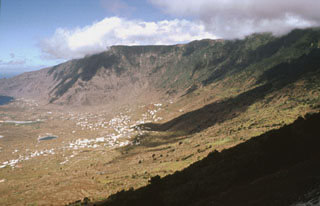Report on Hierro (Spain) — 29 February-6 March 2012
Smithsonian Institution / US Geological Survey
Weekly Volcanic Activity Report, 29 February-6 March 2012
Managing Editor: Sally Sennert.
Please cite this report as:
Global Volcanism Program, 2012. Report on Hierro (Spain) (Sennert, S, ed.). Weekly Volcanic Activity Report, 29 February-6 March 2012. Smithsonian Institution and US Geological Survey.
Hierro
Spain
27.73°N, 18.03°W; summit elev. 1500 m
All times are local (unless otherwise noted)
Instituto Geográfico Nacional (IGN) reported that during 29 February-6 March the seismic amplitude detected by every IGN station in El Hierro remained at very low values. Neither water discoloration nor activity was observed on the sea surface over the emission area. On 5 March, the Scientific Committee stated that the submarine eruption was over, but the volcanic process that started on mid July 2011 had not finished. The Canary Islands Government lowered the Volcanic Alert Code from Red to Yellow, maintaining a maritime exclusion zone around the emission area.
Thirty four seismic events were located, most of them in the central part of the island, extending offshore to the S. Depths of the hypocenters varied between 7 and 24 km, and magnitudes were 0.1-2.1 (twenty eight events were magnitudes equal to or greater than 1). One of these events was felt by residents and had a maximum intensity value of II (EMS-98). GPS data did not show persistent trends in any horizontal or vertical components.
Geological Summary. The triangular island of Hierro is the SW-most and least studied of the Canary Islands. The massive shield volcano is truncated by a large NW-facing escarpment formed as a result of gravitational collapse of El Golfo volcano about 130,000 years ago. The steep-sided scarp towers above a low lava platform bordering 12-km-wide El Golfo Bay, and three other large submarine landslide deposits occur to the SW and SE. Three prominent rifts oriented NW, NE, and S form prominent topographic ridges. The subaerial portion of the volcano consists of flat-lying Quaternary basaltic and trachybasaltic lava flows and tuffs capped by numerous young cinder cones and lava flows. Holocene cones and flows are found both on the outer flanks and in the El Golfo depression. Hierro contains the greatest concentration of young vents in the Canary Islands. Uncertainty surrounds the report of an eruption in 1793. A submarine eruption took place about 2 km SSW off the southern point of the island during 2011-12.

